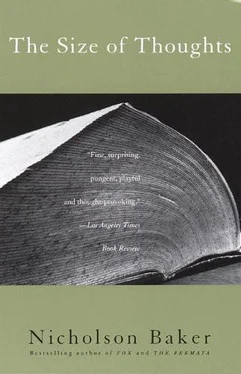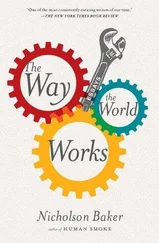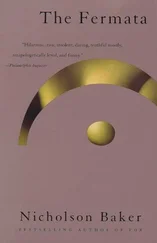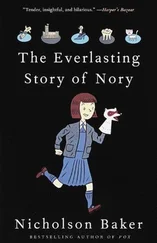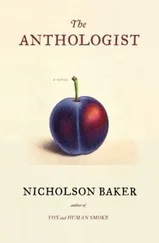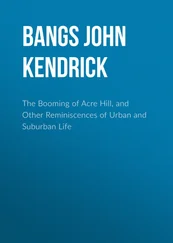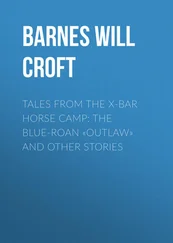Nicholson Baker - The Size of Thoughts - Essays and Other Lumber
Здесь есть возможность читать онлайн «Nicholson Baker - The Size of Thoughts - Essays and Other Lumber» весь текст электронной книги совершенно бесплатно (целиком полную версию без сокращений). В некоторых случаях можно слушать аудио, скачать через торрент в формате fb2 и присутствует краткое содержание. Год выпуска: 1997, Издательство: Vintage, Жанр: Публицистика, Критика, на английском языке. Описание произведения, (предисловие) а так же отзывы посетителей доступны на портале библиотеки ЛибКат.
- Название:The Size of Thoughts: Essays and Other Lumber
- Автор:
- Издательство:Vintage
- Жанр:
- Год:1997
- ISBN:нет данных
- Рейтинг книги:4 / 5. Голосов: 1
-
Избранное:Добавить в избранное
- Отзывы:
-
Ваша оценка:
- 80
- 1
- 2
- 3
- 4
- 5
The Size of Thoughts: Essays and Other Lumber: краткое содержание, описание и аннотация
Предлагаем к чтению аннотацию, описание, краткое содержание или предисловие (зависит от того, что написал сам автор книги «The Size of Thoughts: Essays and Other Lumber»). Если вы не нашли необходимую информацию о книге — напишите в комментариях, мы постараемся отыскать её.
The Size of Thoughts: Essays and Other Lumber — читать онлайн бесплатно полную книгу (весь текст) целиком
Ниже представлен текст книги, разбитый по страницам. Система сохранения места последней прочитанной страницы, позволяет с удобством читать онлайн бесплатно книгу «The Size of Thoughts: Essays and Other Lumber», без необходимости каждый раз заново искать на чём Вы остановились. Поставьте закладку, и сможете в любой момент перейти на страницу, на которой закончили чтение.
Интервал:
Закладка:
In fact, all Bassett’s grooming aids — from emery boards to tweezers — earn high marks among power users. This past August, for example, Jerry Lewis’s secretary called the company directly to order a dozen five-inch triple-cut Trim nail files (with accompanying blue vinyl protective sheaths), because Mr. Lewis couldn’t obtain them locally. “The tweezer is a very fussy item,” Dave Bassett said recently; each Bassett tweezer tip (its inner edge ground “to help grab that hair”) is inspected manually, under a magnifier. The company makes nail clippers plated in gold as well as in chrome; its Heirloom line offers gift sets like the Saddlebag, which includes scissors, a bottle opener, and folding nail files, along with an anchor pair of clippers. This Christmas, Bassett will be selling the Holiday Family Manicure Kit, with a fingernail clipper and a toenail clipper, two wooden cuticle pokers, some emery boards, and a pair of tweezers, displayed against a background of falling snow and rising reindeer. (What better way to spend Christmas morning with one’s loved ones?) For Dr. Scholl’s, Bassett has created an extraordinary matte-black and gold-plated piece of toenail-cleaving insanity that would not be out of place dangling from the rearview mirror of a new forty-valve 3.5-liter Ferrari 355.
It won’t do to labor the parallels between caring for a fingernail and manufacturing a fingernail clipper. Making a clipper is considerably more complex. Still, it is striking how reminiscent of human clippings are the spurned little pieces of scrap metal exiting from the side of the deafening Minster stamping press. Once cut (from rolls of Midwestern steel, at an impact force of roughly fifteen tons), the clipper “blanks” must be cleaned of oil, spot-welded, racked, hardened for two hours in a massive furnace, then oil-quenched, cleaned again, tempered in a second furnace to limber them up a little, and finally revolved in huge barrels with sixty thousand of their fellows for several days in a slurry of metal slugs, abrasives, and lime, to smooth away unhandy burrs. Vibrating bowls dither the components into sequential position, preparing them for a definitive riveting, which is accompanied by a Fred Astaire-like volley of air-cylinder taps and flourishes. Each clipper gets a sharpened cutting edge; a digital image system checks the finished edges for truth. Eyelets, shot in at the caudal end, affix the nail files; then the entire splayed clipper, racked on hooks, proceeds through the plating sequence — ten minutes in a warm nickel bath, a minute or two of chrome. A nimble piece of pneumatics straightens the akimbo file and closes the lever. At last the basic Bassett fingernail clipper is ready for action. You can determine the year your clipper was made by referring to the inside of the lever arm.
Nail care has been weighing on my thoughts recently, I confess, because the great Stephen King, in an introduction to his recent short-story collection, Nightmares & Dreamscapes , describes one of my books as a “meaningless little fingernail paring.” Are we to infer from “paring” that the Bard of Bangor doesn’t possess or know how to operate a Trim (or a Gem, or a Revlon, or even a La Cross) clipper of his own? Does he envision himself as the heir of Joyce’s artist-hero, in A Portrait of the Artist as a Young Man , who was “refined out of existence, indifferent, paring his fingernails”? Does he still whittle? (Bassett’s sales are “really taking off” in Ireland right now, according to Barbara Shannon, the company’s marketing manager; it seems that the Irish are through with Joyce’s manual methods and insist on taking, with Trim’s help, the shortcut to artistry.) Or is Mr. King rather implying that someone like me disdainfully pares and fiddles while he, market-wise progressivist, hacks on with the latest technology?
If so, I can assure Mr. King that I, too, clip — not as often as I should, perhaps, but with genuine enthusiasm. When I want a really authentic experience, I sometimes use a toenail clipper on my fingernails, shuddering with the thrill of fulcrumed power; and then, for my toes, I step on up to Revlon’s veterinary-gauge Nipper, a parrot-beaked personal-pruning weapon that, despite its chrome plate, looks as if it should be stored in the toolshed. A dense, semiopaque shard cut by this nineteen-dollar piece of spring-loaded Brazilian craftsmanship recently rose from what was left of my ravished toenail and traveled across the room, landing in a box of tax records, where it remains.
We can say with some certainty (and sadness) that Nabokov did not use nail clippers. That is, John Shade, Pale Fire ’s poet, did not:
The little scissors I am holding are
A dazzling synthesis of sun and star.
I stand before the window and I pare
My fingernails.…
The cutting of a fingernail is important in Nabokov: it may constitute for him the act of self-liberation from annotative servitude, since he is demonstrably aware of the traditional scholarly use of the nail’s edge as a marginal place-inscriber. In Pushkin’s Eugene Onegin , Tatiana learns about Onegin’s mind by studying his library, and she notices (in Nabokov’s translation) that
Many pages preserved
the trenchant mark of fingernails.
Nabokov’s commentary to these lines mentions Sheridan’s The Rivals (dismissing it in passing, with his usual harshness, as a “singularly inept comedy”), in which someone “cherishes her nails for the convenience of making marginal notes.” Nabokov adds, puzzlingly, “The art is a lost one today.” Hardly so: even with a closely clipped and manly thumbnail, the reader can and very often does, today, in America, score a visible double line to mark an interesting passage, if it appears in a book that he is prevented for one reason or another from defacing. In those midnight moments of the misplaced pencil, too, a nail impression is a less destructive and more spatially precise aid to memory than a turned-down corner. Moreover, the pressure of the reader’s nail, deformed by its momentary trenchancy, against the tender hyponychial tissues it protects, creates a transient thumbwide pleasure that is, or can be, more than literary.
But the most troubling feature of Stephen King’s assessment of my alleged “nail paring” of a novel is his apparent belief that a bookish toe- or fingernail scrap can be justifiably brushed off as meaningless. Last September, Allen Ginsberg sold a bag of his beard hair to Stanford. Surely Mr. King ought to be saving for the ages whatever gnarled relics he clips or pares? And the Master Spellbinder, of all people, should be able to detect the secret terrors, the moans of the severed but unquiet soul, that reside in these disjecta. Think of the fearful Norse ship of the apocalypse, Naglfar , made of dead men’s nails, which will break loose from its moorings during the Monstrous Winter, when the Wolf has swallowed the Sun—“a warning,” in Brian Branston’s retelling, “that if a man dies with his nails unshorn he is adding greatly to the materials for Naglfar (a thing both gods and men would be slow to do).” Gertrude Jobes’s mythological dictionary cites a related Finno-Ugric tradition in which the Evil One collects any Sunday nail parings and “with them builds the boat for transporting the dead.” Lithuanian folklore contends (per Stith Thompson) that “from the parings of man’s nails devils make little caps for themselves.” I didn’t have a chance to ask any of the employees at the factory in Derby, Connecticut, many of whom are first- or second-generation Polish, whether they had heard similar tales.
Lest someone unknowingly aid the devils in their hattery (would a fingernail hat resemble a miniature wicker knick-knack basket, one wonders, or would the snippets be sewn or glued on, like sequins?), the Bassett Company, in 1990, launched the Easy Hold clipper. The Easy Hold line features an unusual pair of either-handed cuticle scissors, with forefinger-rests that aid fine work (U.S. Design Patent No. 331,867); a foam emery-board holder; and an enhanced tweezer that makes the removal of other people’s splinters even more of a wicked joy than it always has been. But the new nail clippers go further: in addition to a considerate plastic thumb element, they include a housing for the jaw that catches nearly every snippet the moment it is clipped.
Читать дальшеИнтервал:
Закладка:
Похожие книги на «The Size of Thoughts: Essays and Other Lumber»
Представляем Вашему вниманию похожие книги на «The Size of Thoughts: Essays and Other Lumber» списком для выбора. Мы отобрали схожую по названию и смыслу литературу в надежде предоставить читателям больше вариантов отыскать новые, интересные, ещё непрочитанные произведения.
Обсуждение, отзывы о книге «The Size of Thoughts: Essays and Other Lumber» и просто собственные мнения читателей. Оставьте ваши комментарии, напишите, что Вы думаете о произведении, его смысле или главных героях. Укажите что конкретно понравилось, а что нет, и почему Вы так считаете.
